Stories posted under Pinkbike Community blogs are not edited, vetted, or approved by the Pinkbike editorial team. These are stories from Pinkbike users.
If a blog post is offensive or violates the Terms of Services, please report the blog to Community moderators.
Titanium vs Performance Steel Coils
Welcome to my suspension blog! Over the coming weeks we will be exploring several topics in mountain bike suspension. All the selected topics will be directly applicable your mountain bike tuning. We will start with Titanium Coils and Performance Steel Coils. Lets get to it!
Traditional steel coils come stock on all coil-sprung mountain bike suspension, but titanium coils have always been the high-performance option. Titanium coils are significantly lighter than their steel counterparts and have a more "lively" feel. Lower weight has always been their biggest selling point, but they have other advantages as well. Titanium is more resilient to fatigue, making it more durable and giving it a longer lifespan than steel. Titanium also doesn't rust. Many mountain bike owners have seen their steel coils rust when the paint or protective coating gets scratched or chipped. Titanium coils have a "bling" factor and are available in a variety of custom colours.
Rust on a traditional steel coil.
It is no surprise that titanium springs reigned supreme for many years, but they are not without problems. First of all titanium coils are not cheap. They currently cost anywhere from $114 to $245 (USD, before shipping or tax).
(Above: The springs with bolded font are performance steel, not titanium)
Second, and most importantly, titanium coils typically have poor spring rate accuracy. I have owned 5 different titanium coils and they have all been at least 25lbs undersprung. It is a chronic issue that I have seen on countless other bikes with titanium coils. In my experience, higher quality (Beta C alloy) titanium coils have better spring weight accuracy, but you will pay more for this higher quality. Here are some specific examples of titanium coils I have owned.
3-4 years ago I bought a 450lbs titanium coil made by Kronos. Although I never got the spring rate measured it was definitely softer than 450lbs. Aside from the coil being too soft it eventually had an orange tinge. A bunch of different people have looked at it and they all agree it looks like it is somehow rusting under the clear coat. Combine this with the incorrect spring rate and you have a very questionable coil quality.
A year Iater purchased a 350lbs titanium coil from one of the bargain titanium companies and the coil was noticeably too soft as soon as it was mounted on my bike. I took it to SuspensionWerx in North Vancouver to have the spring rate tested and it was measured at 225lbs... a whopping 36% softer than it should have been.
To replace the bargain titanium spring I turned to Obtainium. I had ordered a titanium spring from Obtainium years before and had been happy with the product. You pay a premium for Obtainium coils since they are made of Beta C but I wasn't willing to risk wasting money on another unusable coil. The Obtainium coil felt very close to the spring rate I was looking for, and was definitely within a usable range. I got the Obtainium coil tested as well and it was measured at 325lbs. Definitely an improvement over the bargain titanium coil, but still a full increment off of what it should have been.
So titanium springs have some great characteristics, but they are plagued by high price and inaccurate spring rates. So where does performance steel come in?
To my knowledge there are two companies making performance steel coils for mountain bike applications; Stendec and Fox Racing Shox.
Stendec was founded by Dave Garland, one of the most well known world cup mechanics of all time. Stendec's springs are named Super Alloy Springs, but are essentially performance steel. These Super Alloy coils are the same weight or lighter than titanium, are less expensive, and have a spring rate accuracy of 1.5%. In a Pinkbike Article about the Super Alloy springs, Dave Garland says:
"Many riders go straight to the Ti option assuming that Ti is the only choice, but with advances in materials and production processes, Super Alloy Racing Springs are less expensive, lighter, more accurate and less fatigued than an equivalent Ti spring. That's why so many World Cup racers choose SAR."
Dave Garland with a bike outfitted with a Super Alloy Spring
The orange Super Light Steel (SLS) coils from Fox Racing Shox are also high performance steel. Fox says these coils are lighter and more affordable than titanium. These coils are readily available from local bike shops and for performance coils are only beaten in price by the basic Titanium Spring from Ti-Springs.
Overall, the advantages of performance steel coils are:
1. The same weight or lighter than titanium coils
2. Less expensive than titanium coils
3. Far superior spring rate accuracy than titanium coils
The only advantage to titanium coils is that they don't rust (although one of mine did somehow)
Left to right: 375lbs Super Alloy Spring mounted on a Marzocchi Moto, 325lbs Titanium Spring
VERDICT
At this point it doesn't make sense to invest in a titanium coil when you can spend less on a performance steel coil and get a better product. It is no coincidence that most downhill bikes on the World Cup circuit use Stendec Super Alloy and Fox SLS coils. If you want to shave weight off your coil sprung bike, buying a performance steel spring is definitely something to consider.
Follow the blog on Instagram! @mtb_suspension_blog
Follow the blog on Twitter! @mtb_suspension
Have a question? Comment below!
Traditional steel coils come stock on all coil-sprung mountain bike suspension, but titanium coils have always been the high-performance option. Titanium coils are significantly lighter than their steel counterparts and have a more "lively" feel. Lower weight has always been their biggest selling point, but they have other advantages as well. Titanium is more resilient to fatigue, making it more durable and giving it a longer lifespan than steel. Titanium also doesn't rust. Many mountain bike owners have seen their steel coils rust when the paint or protective coating gets scratched or chipped. Titanium coils have a "bling" factor and are available in a variety of custom colours.
Rust on a traditional steel coil.
It is no surprise that titanium springs reigned supreme for many years, but they are not without problems. First of all titanium coils are not cheap. They currently cost anywhere from $114 to $245 (USD, before shipping or tax).
(Above: The springs with bolded font are performance steel, not titanium)
Second, and most importantly, titanium coils typically have poor spring rate accuracy. I have owned 5 different titanium coils and they have all been at least 25lbs undersprung. It is a chronic issue that I have seen on countless other bikes with titanium coils. In my experience, higher quality (Beta C alloy) titanium coils have better spring weight accuracy, but you will pay more for this higher quality. Here are some specific examples of titanium coils I have owned.
3-4 years ago I bought a 450lbs titanium coil made by Kronos. Although I never got the spring rate measured it was definitely softer than 450lbs. Aside from the coil being too soft it eventually had an orange tinge. A bunch of different people have looked at it and they all agree it looks like it is somehow rusting under the clear coat. Combine this with the incorrect spring rate and you have a very questionable coil quality.
A year Iater purchased a 350lbs titanium coil from one of the bargain titanium companies and the coil was noticeably too soft as soon as it was mounted on my bike. I took it to SuspensionWerx in North Vancouver to have the spring rate tested and it was measured at 225lbs... a whopping 36% softer than it should have been.
To replace the bargain titanium spring I turned to Obtainium. I had ordered a titanium spring from Obtainium years before and had been happy with the product. You pay a premium for Obtainium coils since they are made of Beta C but I wasn't willing to risk wasting money on another unusable coil. The Obtainium coil felt very close to the spring rate I was looking for, and was definitely within a usable range. I got the Obtainium coil tested as well and it was measured at 325lbs. Definitely an improvement over the bargain titanium coil, but still a full increment off of what it should have been.
So titanium springs have some great characteristics, but they are plagued by high price and inaccurate spring rates. So where does performance steel come in?
To my knowledge there are two companies making performance steel coils for mountain bike applications; Stendec and Fox Racing Shox.
Stendec was founded by Dave Garland, one of the most well known world cup mechanics of all time. Stendec's springs are named Super Alloy Springs, but are essentially performance steel. These Super Alloy coils are the same weight or lighter than titanium, are less expensive, and have a spring rate accuracy of 1.5%. In a Pinkbike Article about the Super Alloy springs, Dave Garland says:
"Many riders go straight to the Ti option assuming that Ti is the only choice, but with advances in materials and production processes, Super Alloy Racing Springs are less expensive, lighter, more accurate and less fatigued than an equivalent Ti spring. That's why so many World Cup racers choose SAR."
Dave Garland with a bike outfitted with a Super Alloy Spring
The orange Super Light Steel (SLS) coils from Fox Racing Shox are also high performance steel. Fox says these coils are lighter and more affordable than titanium. These coils are readily available from local bike shops and for performance coils are only beaten in price by the basic Titanium Spring from Ti-Springs.
Overall, the advantages of performance steel coils are:
1. The same weight or lighter than titanium coils
2. Less expensive than titanium coils
3. Far superior spring rate accuracy than titanium coils
The only advantage to titanium coils is that they don't rust (although one of mine did somehow)
Left to right: 375lbs Super Alloy Spring mounted on a Marzocchi Moto, 325lbs Titanium Spring
VERDICT
At this point it doesn't make sense to invest in a titanium coil when you can spend less on a performance steel coil and get a better product. It is no coincidence that most downhill bikes on the World Cup circuit use Stendec Super Alloy and Fox SLS coils. If you want to shave weight off your coil sprung bike, buying a performance steel spring is definitely something to consider.
Follow the blog on Instagram! @mtb_suspension_blog
Follow the blog on Twitter! @mtb_suspension
Have a question? Comment below!
Author Info:
Must Read This Week
Sign Up for the Pinkbike Newsletter - All the Biggest, Most Interesting Stories in your Inbox
PB Newsletter Signup
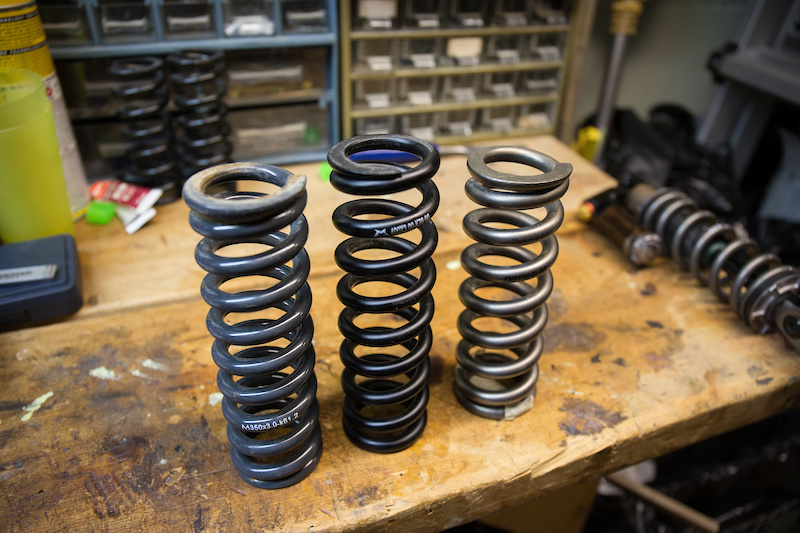

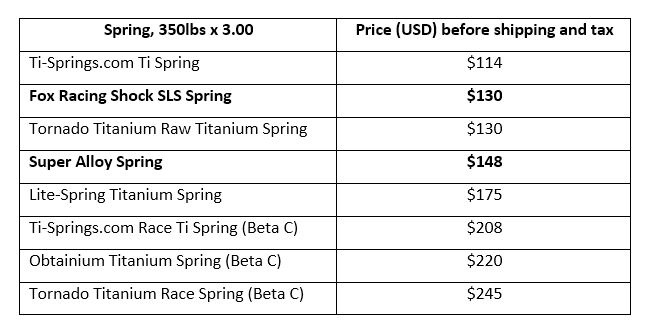
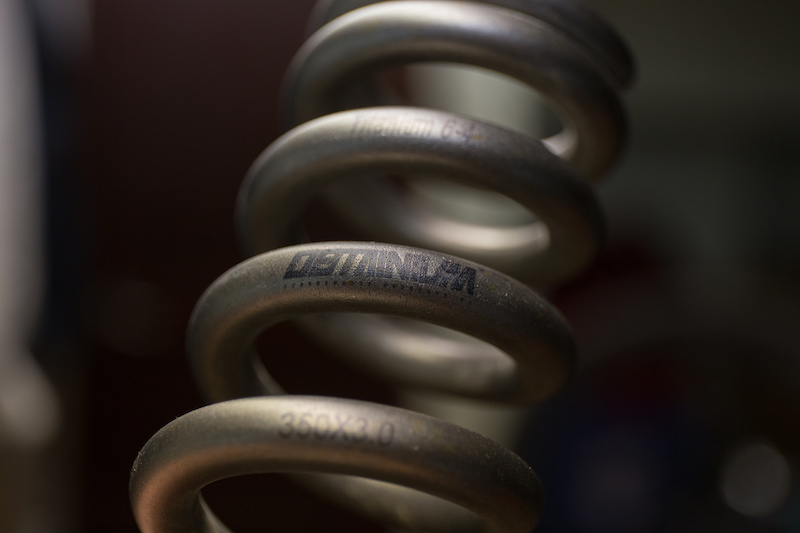
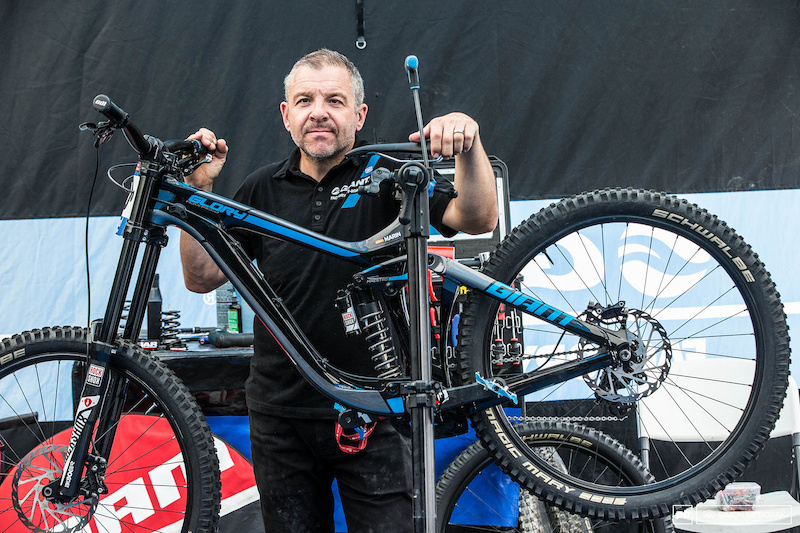

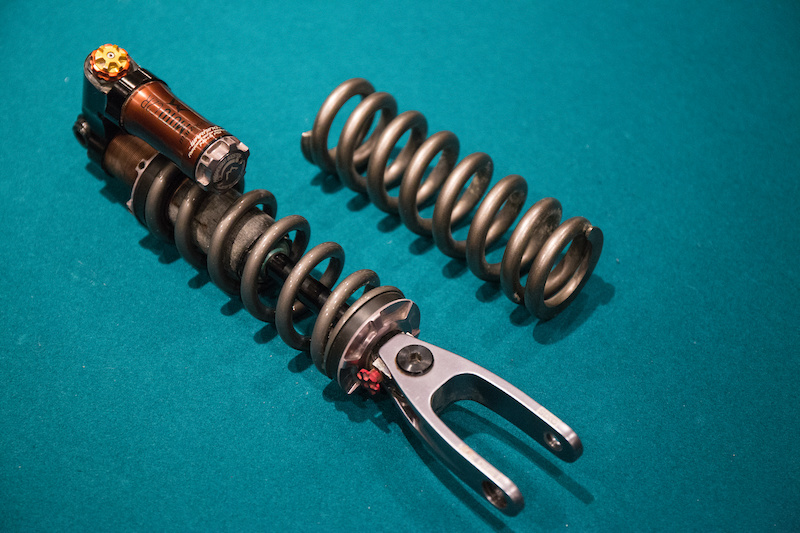

 Member since Jan 6, 2008
Member since Jan 6, 2008
SLS rusting and too expensive shit... TITAN SPRING THE BEST